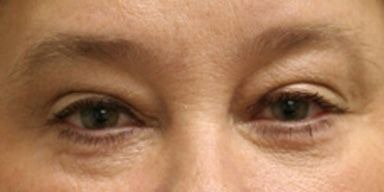Lower Eyelid Surgery in Arcadia, CA
Conveniently located to serve Arcadia, CA
When we think about eyelids, most of us think only about the upper eyelids. Yet we also have lower eyelids that not only serve the crucial function of protecting and moisturizing the eyes, but also play a role in the overall appearance of the face. Like the upper eyelids, the lower eyelids vary between individuals for a host of reasons ranging from genetic to environmental factors.
The discussion below focuses on age-related changes to the lower eyelids that can be cosmetically improved with lower eyelid surgery (also known as lower blepharoplasty). This surgery may be done in conjunction with other surgeries, most commonly upper blepharoplasty and the midface lift.
As normal aging occurs in the face, the lower eyelids may develop “bags.” These bags under the eyes are often the result of fat protruding as the tissue layer holding the fat in weakens over time. Excess muscle can also form bags, as can a number of less common causes. The cheek fat pads also descend over time due to the effects of gravity, revealing hollow semicircular lines under the eyes that can accentuate any lower eyelid bags.
In order to rejuvenate the lower eyelids, lower blepharoplasty may include fat removal or repositioning, removal or resurfacing of skin, and occasionally some removal and redraping of the muscle. The first step to determine if this procedure is safe and likely to achieve your personal aesthetic goals involves seeing a facial plastic surgeon in consultation. Should you visit Dr. Jen Chow, you will also learn about other procedures that can enhance or further promote rejuvenation around the lower eyelids, including the midface lift.
Preparation
There are a variety of techniques for lower eyelid surgery, or lower blepharoplasty, and each has its advantages and disadvantages. Dr. Jen Chow is well versed with the two most common approaches for lower eyelid surgery, which are the trans-conjunctival approach with or without skin pinch, and the transcutaneous approach.
He prefers the trans-conjunctival approach, in which the incision is made behind the eyelid, whenever possible because this safely allows removal of excess fat without causing injury to the eyelid muscle. If skin does not need to be removed, there is no visible scar. When excess skin is also present, a small amount of skin can be removed by direct excision, by chemical peel, or, on occasion, via laser.
Occasionally, when some of the eyelid muscle needs to be removed, or when planning to lift the cheek fat pad during lower eyelid surgery, Dr. Chow will perform the lower blepharoplasty through a direct transcutaneous approach. In this case, the incision is made through the skin just a couple millimeters below the eyelashes. Depending on the cosmetic goals of the procedure, any number of techniques may then be used.
Before Your Lower Eyelid Surgery
During your initial consultation and on any subsequent visits, Dr. Chow will perform a complete history and physical examination of your face and eyes to ensure that lower eyelid surgery will be as safe and effective as possible. He will be happy to discuss any concerns or questions you may have regarding your cosmetic goals.
Before having any cosmetic surgery, you should always review the medications, supplements, vitamins, and foods that you consume. Many of these can cause problems during your procedure because they thin your blood, making you more likely to have heavier bruising or complicating the procedure with excessive bleeding. Others may overly enhance or otherwise interact with the numbing anesthetic used during your lower eyelid surgery.
Dr. Jen Chow should also know your medical history, especially any eye conditions you may have, such as glaucoma. Use of eyeglasses, contacts, and eye medications should be recorded. Any history of dry eye syndrome is very important and should be thoroughly evaluated, as this may be a reason to avoid eyelid surgery. If you have been seeing an ophthalmologist, or eye doctor, you will likely need to be declared safe for blepharoplasty by this physician prior to surgery. Previous surgeries, particularly previous eyelid surgeries, must also be known because they may affect your outcome.
The Day of Surgery
Please be sure to avoid the use of make-up on the day of surgery. If you have previously had a permanent eyeliner tattooed below your eyelashes, be aware that some or all of this tattoo may be removed during surgery as a result of skin excision.
Before the procedure begins, Dr. Jen Chow will meet with you to discuss any last minute questions you may have. He may also make some markings while you are in the sitting position to aid in accurate fat removal during surgery.
Most lower blepharoplasty is performed with an anesthesiologist present at an outpatient surgical facility. An anesthesiologist is a doctor who is responsible for making you comfortable and safely sedated during your procedure. You should plan on having someone to take you to and from the facility and to stay with you overnight on the day of surgery.
Once you are comfortable, Dr. Chow will numb the eyelids. Using sterile techniques, he will then perform the removal or repositioning of fat through either a transconjunctival or transcutaneous approach. Excess skin or muscle will also be addressed. Once the procedure has been completed, your vision may be blurry due to antibiotic ointment or temporary swelling.
You will have a period of recovery afterwards while a nurse or team of nurses watches over you with physician supervision.


* Individual results may vary.
Recovery Info
After Your Lower Eyelid Surgery
You will receive an information packet prior to your surgery explaining what to do and what to expect after lower eyelid surgery (lower blepharoplasty). You will also have access to reach Dr. Chow after hours and during the weekends should you have questions or concerns.
You will have medications to take after surgery, including an eye ointment, an antibiotic to prevent infection, and a pain medication. You may receive medication to reduce swelling as well. It is important to take the medications as prescribed. Feel free to contact the Chow Center if you are unsure about your medications at any time.
You will have a number of required follow up visits immediately after surgery. These visits enable Dr. Chow to see your progress as you recover. Patients are often seen the day after, three days after, and one to two weeks after surgery. Should you decide to have your lower eyelid surgery at the Chow Center, your actual follow up visits may vary depending on your unique circumstances.
FAQ
-
What is lower blepharoplasty?
Also known as lower eyelid surgery, lower blepharoplasty is an operative procedure that rejuvenates the eyes. It is achieved through removal of excess skin and/or muscle and removal or repositioning of excess fat from the lower eyelids.
-
How is the procedure performed?
Please see the description of lower eyelid surgery.
-
Will insurance pay for lower blepharoplasty (eyelid surgery)?
In almost all cases, no.
-
Do I need anesthesia for lower blepharoplasty?
Dr. Jen Chow recommends that most of his patients have the procedure performed under anesthesia, either light intravenous sedation or general anesthesia. This minimizes discomfort (when used along with local anesthetics that numb the lower eyelid). The procedure is commonly performed in an outpatient setting (you will go home after the procedure). When this procedure is combined with others, such as the endoscopic brow lift, the midface lift, facelift, and upper blepharoplasty, general anesthesia is usually recommended.
-
How long does the surgery take?
In general, Dr. Chow performs most eyelid surgeries in less than an hour. However, there is never a time limit, and his focus is on safety and excellent results rather than speed. Therefore, the overall time may vary depending on a host of factors, including your eyelid shape and function, aesthetic concerns, and even the type of anesthesia used.
-
Will I have bruising after lower blepharoplasty?
Most patients experience some level of bruising and swelling after surgery. This can last several weeks, depending on the person. Many patients are presentable and return to work within one to two weeks.
-
When are the stitches (if any) removed?
Not everyone will have stitches after surgery. Those that do not require skin excision or a transcutaneous approach will have no stitches. For those that do, however, stitches are removed 3-4 days after surgery.
-
Are there scars after lower blepharoplasty?
There can be scarring after any surgery involving an incision. However, through the transconjuctival approach, in which the majority of the surgery is done behind the eyelid, the scar is hidden.
-
What are the risks of lower blepharoplasty?
Before surgery, you will have an in depth discussion with Dr. Chow about the risks and benefits of the procedure. You will also receive an information packet that includes many of the major risks of this surgery. Fortunately, most eyelid surgery complications are infrequent and minor when performed by a competent facial plastic surgeon. All patients should expect some bruising and swelling after surgery, as well as possible blurry vision from the use of eye ointments and/or swelling immediately after surgery. More serious complications, including, but not limited to, chronic dry eye, inability to close the eyelid, bleeding, infection, heavy scarring, out-folding of the eyelid, and permanent vision changes are also possible, but thankfully much less common.
-
I have already had a lower blepharoplasty and desire revision surgery. Is this possible?
Dr. Chow does perform revision lower eyelid surgery. However, he does not recommend any revision procedures before at least one year has passed since the prior surgery. The best way to determine if revision surgery is right for you is to schedule an appointment at the Chow Center for a detailed consultation in a friendly environment.
-
Will lower blepharoplasty help with the dark circles under my eyes?
If the circles are caused by shadows cast by large bags beneath the eyes and/or hollowness in the tear trough area, fat repositioning during lower eyelid surgery can improve these dark circles. The use of fillers such as Restylane or Juvederm can also fill in the tear trough area. However, there are also many other reasons for dark circles beneath the eyes, including allergies, thin skin overlying prominent (and purple) muscle, swollen veins, and hyperpigmentation (darkening) of the skin. These will not be improved by lower eyelid surgery.
-
When will I be able to see the results?
After the swelling and bruising has subsided, you will be able to see a definite difference. Because every individual is unique, this time period varies. Most improve within one to two weeks.
-
When can I exercise after my lower blepharoplasty?
Although you may feel ready to resume your normal physical activity within days after surgery, you should refrain from exercise for a week after surgery. During the second week after surgery, you can begin to engage in lighter exercises, avoiding prolonged aerobic workouts and heavy lifting. After three weeks, you should be able to safely resume any and all of your usual physical activities.
-
What other procedures can be combined with lower blepharoplasty?
A number of other aesthetic procedures are often combined with upper eyelid surgery. These include lower blepharoplasty, brow lift, facelift, necklift, midface lift, neck liposuction, and skin resurfacing.

